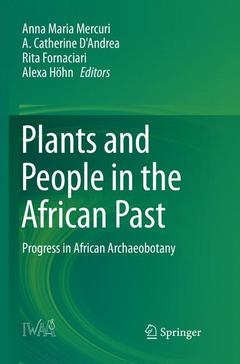Plants and People in the African Past, Softcover reprint of the original 1st ed. 2018 Progress in African Archaeobotany
Coordonnateurs : Mercuri Anna Maria, D'Andrea A. Catherine, Fornaciari Rita, Höhn Alexa

There is an essential connection between humans and plants, cultures and environments, and this is especially evident looking at the long history of the African continent. This book, comprising current research in archaeobotany on Africa, elucidates human adaptation and innovation with respect to the exploitation of plant resources. In the long-term perspective climatic changes of the environment as well as human impact have posed constant challenges to the interaction between peoples and the plants growing in different countries and latitudes. This book provides an insight into/overview of the manifold routes people have taken in various parts Africa in order to make a decent living from the provisions of their environment by bringing together the analyses of macroscopic and microscopic plant remains with ethnographic, botanical, geographical and linguistic research. The numerous chapters cover almost all the continent countries, and were prepared by most of the scholars who study African archaeobotany, i.e. the complex and composite history of plant uses and environmental transformations during the Holocene.
Introduction.- 1. Archaeobotanical study of plant diversity at Early Dynastic Helwan (3100-2600 B.C.); Egypt; Adel M. Ahmed et al.- 2. The archaeobotanical remains found in valley of the King (kv 63), Luxor, Egypt; Rim S. Hamdy, Ahmed G. Fahmy.- 3. Diet and trade in Amheida /Trimithis (Dakhleh Oasis - Egypt), new insights from the archaeobotanical analysis; Valentina Caracuta et al.- 4. Archaeobotanical studies from Hierakonpolis – evidence of food processing during the Predynastic period in Egypt; Elshafaey Abdelatif Elshafaey Attia et al.- 5. Grapes, raisins and wine? Archaeobotanical Finds from an Egyptian Monastery; Mennat-Allah El Dorry.- 6. Integrated analyses of ancient wild cereals from Takarkori rock shelter (SW Libya); Rita Fornaciari et al.- 7. The Holocene vegetation of Tin Hanakaten cave (Tassilin'Ajjer, Algerian Sahara central); Samira Amrani.- 8. The use of wild plants in the Palaeolithic and Neolithic of NW Africa: preliminary results from the paleoplant project. (formerly: Plant use in northern Africa during the Early Holocene); Yolanda Carrión et al.- Archaeology and Palaeoecology: integrated methods.- 9. The translocation of useful trees in African prehistory; Roger Blench.- 10. Mid-Holocene environmental change at Mtwapa Creek, Kenya: distinguishing human activity from regional ecological processes; Ryan M. Szymanski.- 11. Multiscalar perspectives on Holocene climatic and environmental changes: Saharan and Nile Corridor patterns with special consideration of Sai Island archaeological sites; Elisabeth Hildebrand et al.- 12. Pollen analyses of sediments from an archaeological deposit in Motako, southwest Nigeria; Kingsley C. Daraojimba et al.- 13. Pits at Pangwari: thoughts on the taphonomy of charcoals from several pits at a multi-phased Nok site, Central Nigeria; Alexa Höhn et al.- Plant Use, Agricultural History and Ethnoarchaeology: Foods and Fields.- 14. Agriculture in sub-Saharan Africa by 1800 - a map and a gazetteer (formerly: Agricultural systems in sub-Saharan Africa 1800: a preliminary map); Mats Widgren.- 15. Agriculture and wild plant use in the Middle Senegal River Valley, ca. 800 BC - 1000 AD; Daphne Gallagher et al.- 16. The archaeobotany of the Late Stone Age (LSA) in Nigeria: a review; Emuobosa A. Orijemie.- 17. Cottoning on to cotton (Gossypium spp.) in Arabia and Africa in antiquity; Charlène Bouchaud et al.- 18. Sorghum Domestication and Diversification: A current archaeobotanical perspective (formerly: Sorghum domestication revisited); Dorian Q. Fuller, Chris Stevens.- 19. Pre-Aksumite culinary practice at the Mezber site, northern Ethiopia (formerly: Ethnoarchaeological and microbotanical studies of grindingstones from northern Ethiopia); A. Catherine D’Andrea et al.- Climate and Agrarian-Cultural Landscapes.- 20. Combined culture-vegetation-climate dynamics in the African Tropics: paleoenvironmental assessment of Late Iron Age vegetation change in the Ngotto Forest, Central African Republic; Christopher A. Kiahtipes.- 21. Filling the gap: evidence of sorghum cultivation and introduced west Africa crops in the Second Millennium BC at Kasala, Eastern Sudan (formerly: Filling the gap: new archaeobotanical evidence for 3rd-1st Millennium BCE agrucultural economy in Sudan and Ethiopia); Alemseged Beldados et al.- 22. New evidence on the development of millet and rice economies in the Niger River basin: archaeobotanical results from Benin; Louis Champion, Dorian Q. Fuller.- 23. Pollen-based landscape reconstruction and land-use history in the southern Tunisian desert margins since 6000BC (formerly: Anthropogenic impact and landscape shaping in southern Tunisia during the Holocene); Sahbi Jaouadi, Vincent Lebreton.- Index.
Contributions/chapters cover famous archaeological sites or regions from the Nile Valley to the Nok Region in West Africa
Covers the current archaeobotanical research on the African continent
Gives insight into different archaeobotanical methods, from the analyses of macro-remains like seeds to micro-remains like pollen
Gives the reader an impression of the multi-facetted research on the African continent
Date de parution : 01-2019
Ouvrage de 576 p.
15.5x23.5 cm
Date de parution : 09-2018
Ouvrage de 576 p.
15.5x23.5 cm
Thème de Plants and People in the African Past :
Mots-clés :
Africa; Archaeobotany; Palynology; Paleoenvironment; Ethnoarchaeology
